

DoB unknown – 1st May 1801. CHILD STAR, COUNTER TENOR, ORCHESTRAL MUSICIAN AND COMPOSER Relation to me: 4 x great grandfather through my father.
WALCOT STREET We know that when he died, Thomas was living at 31 Walcot Street (now a specialist cheese shop) and the family may already have been living there by the time their next son, Christopher, was born in 1797. (He would become my 3 x great grandfather).
By the end of the 18th Century, Bath was pretty much as we see it today. The next significant developments for Thomas were the opening of Grosvenor Gardens to the north of the city and Sydney Gardens at the far end of Great Pulteney Street over the bridge. All this affected the popularity of the Spring Gardens and they closed in 1798.
Sydney Gardens were accessed through the Sydney Hotel, the present day Holbourne Museum, and with the surrounding gardens and the canal walks, this became the most popular venue, with guests able to order food and have it delivered to their tables, while the musicians played on the balcony or later around the gardens.
The last concert of the season in 1798 shows Thomas and his compatriots singing for a very crowded evening of entertainment including significant fireworks, all described in great detail, plus the latest craze which was a mechanical puppet show called Fantoccini which had come over from Italy.
BATH HARMONIC SOCIETY Meanwhile, Thomas became a founding member of the Bath Harmonic Society which was set up by Dr Harington after he abandoned the Catch Club. Membership was restricted to the nobility and gentry and professional singers. From the start, the company rules were strict and their first rule stated
‘This Society is established for the promotion of harmony… in order to preserve which, no political discussion shall be suffered to take place, nor shall any indecent song or sentiment be permitted to be sung or spoken on any account’
Members of the club included the Prince Regent himself and Henry Petty-Fitzmaurice, who would later become Chancellor of the Exchequer.
The society employed 8 professional singers of which one was Thomas, singing counter tenor. A review of a particularly successful evening is written up in the Bath Herald.
Things seemed to have reached a pinnacle when in the March of 1800, a complaint appeared in the newspaper that Thomas had been missed out of the review of Ladies’ Night – a very popular evening which had taken place in the Lower Assembly Rooms with 435 tickets being printed up and allegedly sold.
Thomas certainly lived through some interesting times and in the May of 1800, King George IIIrd survived two assassination attempts in one day, the first being in the morning when he inspected his troops and the second in the evening when he went to the Theatre Royal in Drury Lane. James Hadfield had decided to take a pot shot at the King in his box. He missed and the King went to the front of the box and looked around at the audience beneath, earning him much needed cudos! The play went ahead and at the end Richard Sheridan and the company sang the national anthem with an extra verse that Sheridan himself had penned while the rest of the play continued.
From every latent foe
From the assassin’s blow
God save the King
O’re Him thine arm extend
For Britain’s sake, defend,
Our father, King and friend
God save the King!
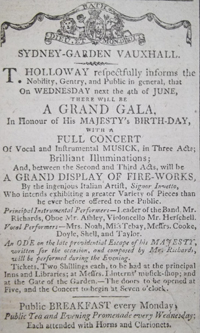
Gala at the Sydney Gardens June 4th 1800
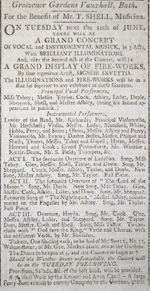
Benefit concert for Thomas, June 10th 1800
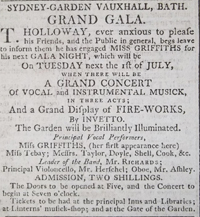
Bath Chronicle 26th June 1800
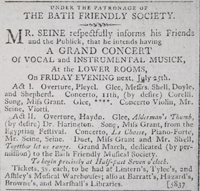
Bath Chronicle 24th July 1800
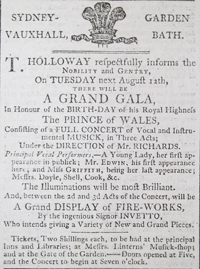
Bath Chronicle 7th Aug 1800
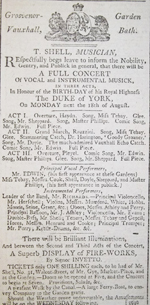
Bath Chronicle 14th Aug 1800
The public took this to its heart and within weeks, performances were enhanced either by the singing of the National Anthem with this added verse, or as here, recitation of an Ode to celebrate his lucky escape.
FUTURE STARS JUNE 10TH 1800 On June 10th, Thomas had his own benefit concert which took place at the new Grosvenor Gardens site. Thomas was busy in this concert and along with performing and possibly helping organise it, he sells tickets from the house in Walcot Street. Note that in this concert, the extra verse of the national anthem is being sung!
In this concert, James Windsor in on the pianoforte and playing double bass next to Thomas is John Philpot. James played the piano for the Harmonic Society and was a very fine pianist, and also a distant cousin to the Philpots. He was to end up teaching Lucy, the daughter of John Philpot, who in turn would have a glittering career under her married name of Lucy Anderson and went on to teach Queen Victoria and her children piano.
It should be noted however that at this time, she was not yet 3 years old! It is an intriguing possibility that Thomas and John chatted about their offspring and if they were showing any musical leanings!.
SUMMER 1800 During the summer season Thomas was busy playing and singing in concerts at Sydney Gardens, one being for the Friendly Society which had masonic implications. Viotti was a regular visitor to Bath and it looks like he played his own violin concerto with Seine (a well known pianist) accompanying him. There is also music by Corelli and Thomas sings a duet from Solomon by William Boyce.
On 18th August, Thomas put on another concert at Grosvenor Gardens and invites the public to attend to celebrate the birthday of the Duke of York, Prince Frederick. There are compositions by Haydn, Rauzzini and Pleyel with comic songs and catches and glees.
FINAL MENTION The last concert of the season and the last time we hear of Thomas was on 9th September 1800 back at Sydney Gardens.
By now, Thomas and Hester had buried two young children and had two boys who survived, Thomas and Christopher. In the September, a healthy little girl, Ann Wight Shell, was born. Their growing family will have required some more income. Once the Bath season closed down, musicians had to turn to other sources of money, like teaching and composition. Thankfully for us, Thomas did precisely that.
LAURA CHAPEL The chapel had been built in 1795 in Henrietta Street, just over Pulteney Bridge, for the residents of the new area of Bath. It was named after the daughter of Sir Willam Pulteney and was run by the reverend Dr, Francis Randolph. The chapel seated 1,000 and Dr Randolph was frequently found giving a thunderous sermon in the pulpit.
DR RANDOLPH’S UNFORTUNATE INCIDENT – A MAJOR SCANDAL It was while he was chaplain to the Duke of York that an unfortunate incident took place bringing notoriety to the Reverend Doctor. In 1795 he was entrusted with some letters from the Princess of Wales, Caroline of Brunswick, to her family in Germany. Prevented from going, Dr Randolph put the letters in a coach and sent them from London back to the Princess at Brighton. Unfortunately the letters got lost on this journey. The press believed that Lady Frances Jersey, whom Caroline detested, and who was, at that time the lover of the Prince of Wales and a malicious and spiteful woman, had intercepted the letters and made known the contents, many of which were some rather free reflections on Queen Charlotte herself. Randolph had to publish his full version of the account leading to much amusement in the press and public.
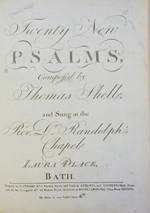
Cover Plate for the Twenty Psalms
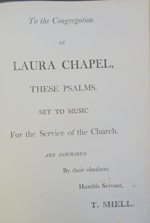
Dedication to the Congregation
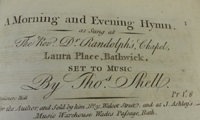
The Opening and Closing Hymns were more substantial
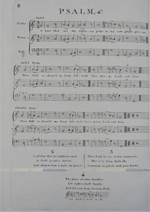
One of the Psalms
TWENTY NEW PSALMS None of this hindered Randolph and his work at the Laura Chapel, indeed it might have swelled the ranks of the congregation. It is unclear whether Thomas was involved with the chapel as choir master or whether he was just commissioned to write the psalms but in 1801, Thomas published 20 new psalms and Dr Randolph ordered 100 copies.
The settings were of psalm texts by Nahum Tate, best known for his libretto to Dido and Aeneas by Purcell, though the opening Morning and Evening Hymn had a text by Thomas Ken. The compositions show that the congregation must have had some skill in singing, but presumably there was a chapel choir to help and there are some duet options within the pieces for soloists, possibly Thomas himself.
Janet discovered this edition held at the British Library and there is another one at the Bodleian Library in Oxford.
The music shows that it was registered at Stationer’s Hall in London in order to protect copyright. This was relatively new for music although had been around since about 1710 for the written word. It did mean that anybody entering their work had to provide a complimentary copy to the hall and it is thanks to this that we can see Thomas’s work today.
For a Christmas concert in December 2016, Christopher Goldsack took the most interesting of these settings (the Morning and Evening Hymn) and, searching for a suitable carol to fit the metre, alighted on While shepherds watched their flocks by night. Coincidentally he realised this text was also penned by Nahum Tate. He recorded his Promenade Project Choir singing it – quite possibly the first time the music of Thomas Shell has been heard in public for 200 years.
SUBSCRIBERS In order to afford to publish, composers would have to attract subscribers to order advanced copies and in the back of the British Library edition, the list of those of Thomas for this work and the number of copies ‘purchased’ is included.
James Windsor and John Philpot have both subscribed as have the Cantelos and Mr Cook; several members of the gentry, various music shops and one Honourable Mr William Wilberforce who ordered 2 copies. In 2017 I contacted the current family and although they had not seen this music, they were interested in the information.
Wilberforce had connections in Bath as he met and married his wife Barbara in the city. They married at St Swithin’s Church, Walcot which was where Thomas’s son, Christopher was to be married. A notable omission to the list is that of Rauzzini.
In total there were 215 subscribers who paid 1/6 per copy. Non subscribers paid 4 shillings and even without taking those into account, Thomas did very well out of the venture.
317 copies were sold in advance giving him the equivalent of £28. In those days £1 = £100 today meaning he earned well over £2,000.
APRIL 1801 DEATH Thomas was buried at St. Michael’s Church on May 1st 1801. Young Thomas was 5, Christopher had just turned 4 and Ann was 1 year old. Hester was to have one more daughter, Eliza, born in the December of that year, but they may not even have known yet that she was pregnant.
His age at death is not known but my guess is that he must only have been in his 30s. He was clearly a man who found a way to make a living in that over musically subscribed city and he had acquaintances in high society through his musical abilities. He rubbed shoulders with some of the great singers and musicians of the day and left a legacy in his compositions and his 4 children, two of whom stayed in the musical traditions that Thomas had set up and one of whom also composed music.
But his legacy stretches further down the centuries of course with singing. One of his 4 X great grandsons has a natural counter tenor voice which although not used professionally, has had the quality to have been, a 2 X great granddaughter took up singing professionally; his 2 X great grandson sang in a close harmony group; 2 of his 4 X great granddaughters sing professionally and the musical gene continues to be played out. Thank you Thomas!
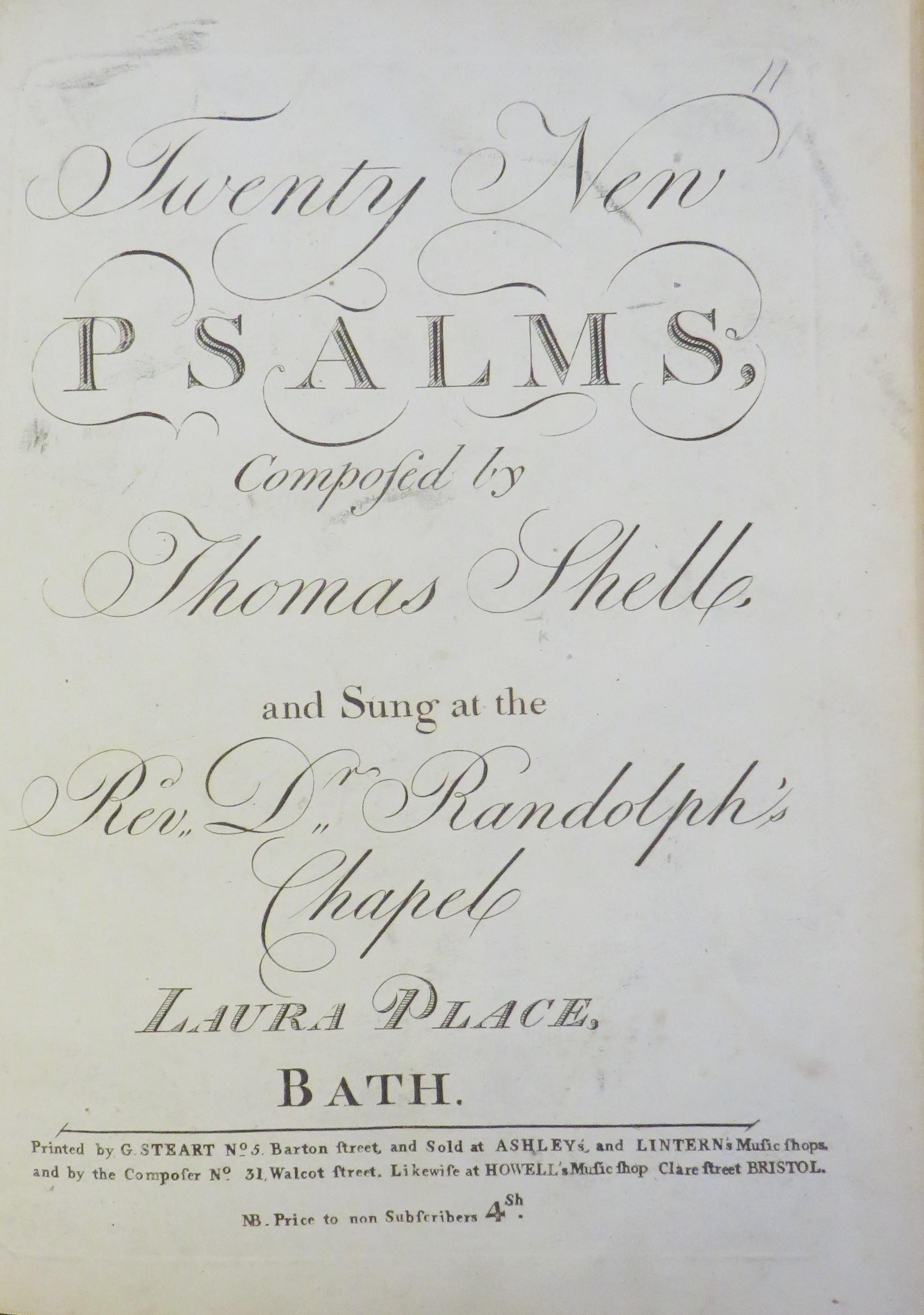
The book of Psalms composed by Thomas Shell